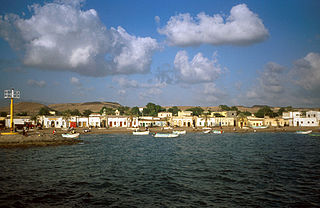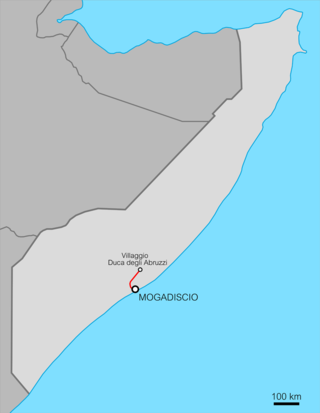
Transport in Ethiopia is overseen by the Ministry of Transport and Communications. Over the last years, the Ethiopian federal authorities have significantly increased funding for rail and road construction to build an infrastructure, that allows better economic development.

Dire Dawa is a city in eastern Ethiopia near the Oromia and Somali Region border and one of two chartered cities in Ethiopia. Dire Dawa alongside present-day Sitti Zone were a part of the Dire Dawa autonomous region stipulated in the 1987 Ethiopian Constitution until 1993 when it was split by the federal government into a separately administered chartered city.

Awash Subah is a market town in central Ethiopia. Located in Administrative Zone 3 of the Afar Region, above a gorge on the Awash River, after which the town is named, the town lies on the Addis Ababa–Djibouti Railway, which crosses the gorge by a bridge there. It is the largest settlement in Awash Fentale woreda.

Tadjoura is one of the oldest towns in Djibouti and the capital of the Tadjourah Region. The town evolved into an early Islamic center with the arrival of Muslims shortly after the Hijra. An important port for many centuries, it was ruled by a succession of polities, including the Ifat Sultanate, Adal Sultanate, the Ottoman Empire, France until Djibouti's independence in 1977. Lying on the Gulf of Tadjoura, it is home to a population of around 45,000 inhabitants. It is the third-largest city in the country after Djibouti and Ali Sabieh.
Rail transport in Ethiopia is done within the National Railway Network of Ethiopia, which currently consists of three electrified standard gauge railway lines: the Addis Ababa–Djibouti Railway, the Awash–Weldiya Railway and the Weldiya–Mekelle Railway. Other lines are still in the planning phase. There is also an urban light rail system in the country's capital, the Addis Ababa Light Rail.

Kenya Railways Corporation (KRC), also Kenya Railways (KR) is the national railway of Kenya. Established in 1977, KR is a state corporation.

The Port of Djibouti is a port in Djibouti, the capital of Djibouti. It is strategically located at the crossroads of one of the busiest shipping routes in the world, linking Europe, the Far East, the Horn of Africa and the Persian Gulf. The port serves as a key refueling and transshipment center, and is the principal maritime outlet for imports to and exports from neighboring Ethiopia. An estimated 2,500 ships pass through and call through the port every day.

Mojo is a town in central Ethiopia, named after the nearby Modjo River. Located in the East Shewa Zone of the Oromia Region, it has a latitude and longitude of 8°39′N39°5′E with an elevation between 1788 and 1825 meters above sea level. It is the administrative center of Lome district.
Dewele is a town in Ethiopia, near to the Ethiopia and Djibouti border. Located in the Sitti Zone in the Somali Region the town has a longitude and latitude of 11°2′N42°37′E with an elevation of 898 meters above sea level.

Current railway stations in Ethiopia are served by standard gauge railways of the National Railway Network of Ethiopia which is mostly under construction, except the Addis Ababa–Djibouti Railway. Other stations were built for the in 2018 still operating metre gauge Ethio-Djibouti Railways, although this railway has officially been superseded by the new Addis Ababa-Djibouti Railway.

The Ethio-Djibouti Railway is a metre gauge railway in the Horn of Africa that once connected Addis Ababa to the port city of Djibouti. The operating company was also known as the Ethio-Djibouti Railways. The railway was built in 1894–1917 to connect the Ethiopian capital city to French Somaliland. During early operations, it provided landlocked Ethiopia with its only access to the sea. After World War II, the railway progressively fell into a state of disrepair due to competition from road transport.
Rail transport in Djibouti is administered through the Ethio-Djibouti Standard Gauge Rail Transport Share Company, a bi-national company between Ethiopia and Djibouti to manage the only railway in Djibouti, the electrified standard gauge international Addis Ababa–Djibouti Railway. This railway opened on 1 January 2018 replaced the international metre gauge railway from Djibouti's capital Djibouti City to the Ethiopian capital Addis Ababa, which was officially decommissioned in 2016.

Railway transport in Somalia consisted of the erstwhile Mogadishu–Villabruzzi Railway and secondary tracks. The system was built during the 1910s by the authorities in Italian Somaliland. Its track gauge was 950 mm, a gauge favoured by the Italians in their colonies in the Horn of Africa and North Africa. The railway was dismantled in the 1940s by the British during their military occupation of Italian Somaliland, and was subsequently never rehabilitated.

The Addis Ababa–Djibouti Railway is a new standard gauge international railway that serves as the backbone of the new Ethiopian National Railway Network. The railway was inaugurated by Prime Minister Hailemariam Desalegn on January 1, 2018. It provides landlocked Ethiopia with access to the sea, linking Ethiopia's capital of Addis Ababa with Djibouti and its Port of Doraleh. More than 95% of Ethiopia's trade passes through Djibouti, accounting for 70% of the activity at the Port of Djibouti.

Legeharetrain station was the main railway station in Addis Ababa, Ethiopia, the terminal station of the metre-gauge Ethio-Djibouti Railway that connected Ethiopia's capital to the Port of Djibouti. Completed in 1917, the station was a central part of the city and the main source of traffic into the city. The style of the station is French, reflecting the nationality of its builders. The station is no longer in operation, as the metre-gauge railway has been largely superseded by the standard-gauge Addis Ababa–Djibouti Railway completed in 2017. The standard-gauge station is located in the outskirts of Addis Ababa.

The Italian colonial railways started with the opening in 1888 of a short section of line in Italian Eritrea, and ended in 1943 with the loss of Italian Libya after the Allied offensive in North Africa and the destruction of the railways around Italian Tripoli. The colonial railways of the Kingdom of Italy reached 1,561 kilometres (970 mi) before WWII.

Nagad Railway Station is the new and only passenger rail station of Djibouti City, the capital of Djibouti.

The Awash–Weldiya Railway is a standard gauge railway under construction, that will serve as a northward extension of the new Ethiopian National Railway Network.
The Kenya Standard Gauge Railway is a railway system that will connect Kenyan cities, and link the country to the neighboring country of Uganda, and through Uganda, to South Sudan, the Democratic Republic of the Congo, Rwanda, and Burundi. There are also plans to link to Addis Ababa, in neighboring Ethiopia to the north. The first segment, between Mombasa and Nairobi, opened passenger rail service in June 2017, and freight rail service in January 2018. Other segments are under construction or planned. The new Standard Gauge Railway (SGR), is intended to replace the old, inefficient metre-gauge railway system.















